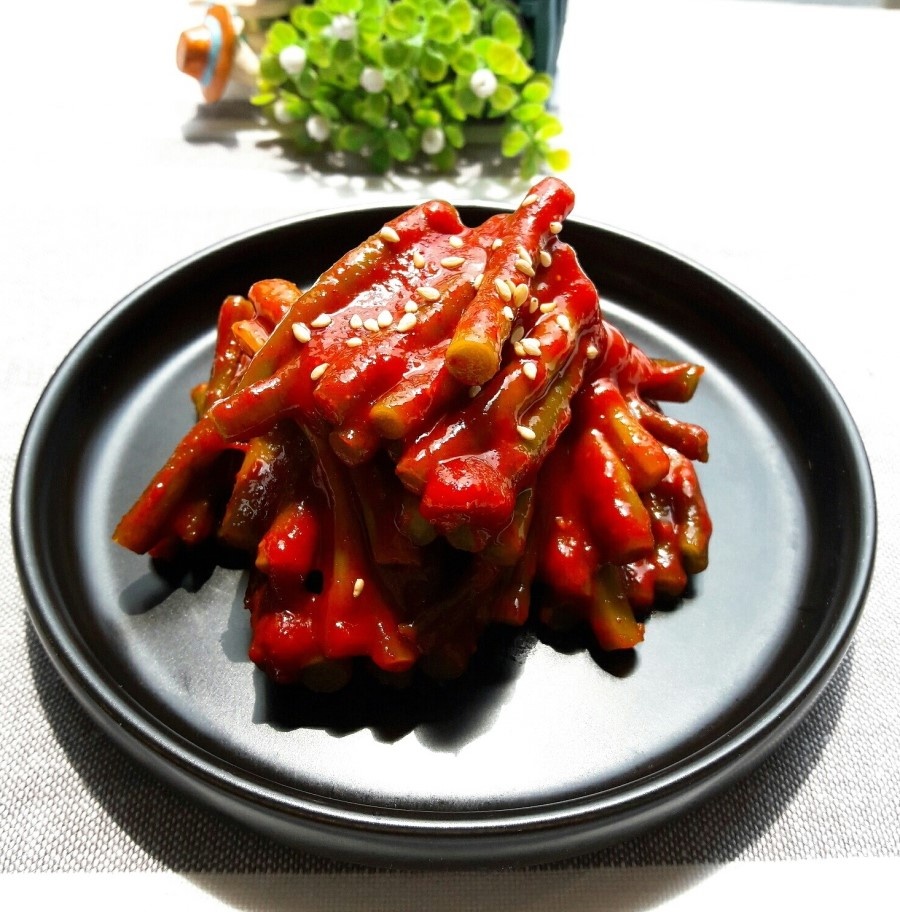Garlic Scape Gochujang Jangajji: A Satisfying Seasonal Side Dish for the Entire Year
How to Make Delicious Garlic Scape Gochujang Jangajji (Preserved Vegetable)

Preserve the season’s bounty with this flavorful garlic scape gochujang jangajji! This side dish is a wonderful way to stock your pantry for the year ahead. Its spicy, sweet, and savory taste is incredibly appetizing, and the satisfying crunch makes it a perfect accompaniment to rice. This ‘magic’ flavor is impressive enough for special occasions or when entertaining guests. Let’s reveal the secret to making this delicious jangajji!
Garlic Scape Jangajji Ingredients- 1.4kg garlic scapes
- 1kg gochujang (Korean chili paste)
- 1.5 cups coarse sea salt (approx. 300g)
- 4 cups corn syrup (approx. 800ml)
- 12 cups water (approx. 2.4L)
- String or chives for tying
Cooking Instructions
Step 1
First, clean and prepare the garlic scapes. Trim off any messy or tough parts, then lightly rinse under running water and pat dry. Cut them into manageable lengths of about 15-20cm and tie them neatly into bundles. Using kitchen twine or chives will make this easier. Tying them into bundles will make it more convenient to handle and store the jangajji later. Aim for about half a handful per bundle.

Step 2
Arrange the tied garlic scapes neatly in a clean pickling jar or earthenware pot. In a separate bowl, combine 12 cups of water and 1.5 cups of coarse sea salt, stirring until the salt is completely dissolved. Pour this brine over the garlic scapes, ensuring they are fully submerged. Place a heavy stone or a plate on top to keep the scapes from floating. Leave it at room temperature for one week, flipping the bundles every 4-5 days to ensure even pickling.

Step 3
After a week, carefully remove the garlic scapes from the brine and rinse them thoroughly under running water. Soak the rinsed scapes in fresh cold water for about 3 hours to remove excess saltiness. Changing the water once or twice during this time will further help. Drain the scapes well in a colander, ensuring all excess water is removed. It’s crucial to get rid of any remaining moisture to prevent the jangajji from becoming mushy or spoiling.

Step 4
Once the water has been completely removed, place the garlic scapes back into a clean container. Now, pour 4 cups of corn syrup evenly over the garlic scapes. Let them sit at room temperature for another 10 hours to allow the syrup to work its magic. This step helps to draw out moisture and infuse the scapes with sweetness.

Step 5
After soaking in corn syrup for 10 hours, gently rinse the garlic scapes again under running water to wash off the syrup. Be careful not to wash too vigorously, as this could diminish the flavor. Afterwards, thoroughly pat them dry using clean kitchen towels or cloths. Ensuring they are completely dry is vital for preserving the jangajji.

Step 6
Now it’s time to coat the dried garlic scapes with gochujang. Using your hands (or gloves if preferred), spread a layer of gochujang onto each garlic scape bundle. You can adjust the spiciness by adding a touch of honey or sugar if desired. Arrange the coated scapes neatly and place them back into the clean container.

Step 7
Once the garlic scapes are arranged in the container, cover the top with the remaining gochujang. This helps to prevent the scapes from being exposed to air, keeping them fresher for longer. Seal the container tightly and store it in the refrigerator.

Step 8
This is the garlic scape gochujang jangajji after 20 days of refrigeration. The flavors have deepened beautifully, making it incredibly delicious! Jangajji generally develops a richer, more complex flavor with a longer aging period. The unique pungent taste of garlic scapes, the spiciness of gochujang, and the sweetness of corn syrup create a fantastic harmony.

Step 9
To serve, cut the well-ripened jangajji into bite-sized pieces and arrange them on a plate. Lightly brush off some of the excess gochujang and sprinkle with toasted sesame seeds for an appealing finish. Placing a piece on a spoonful of rice will bring back your appetite with its magical taste!




